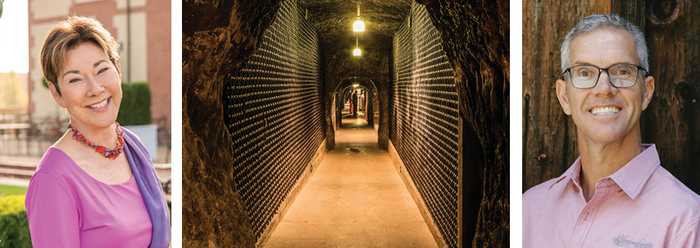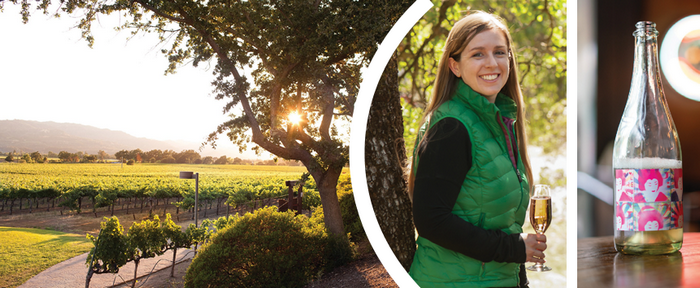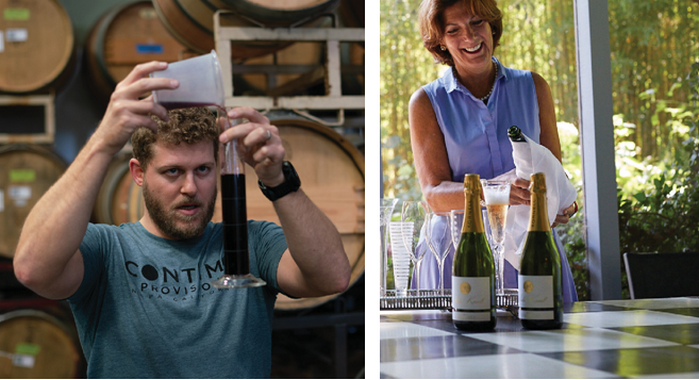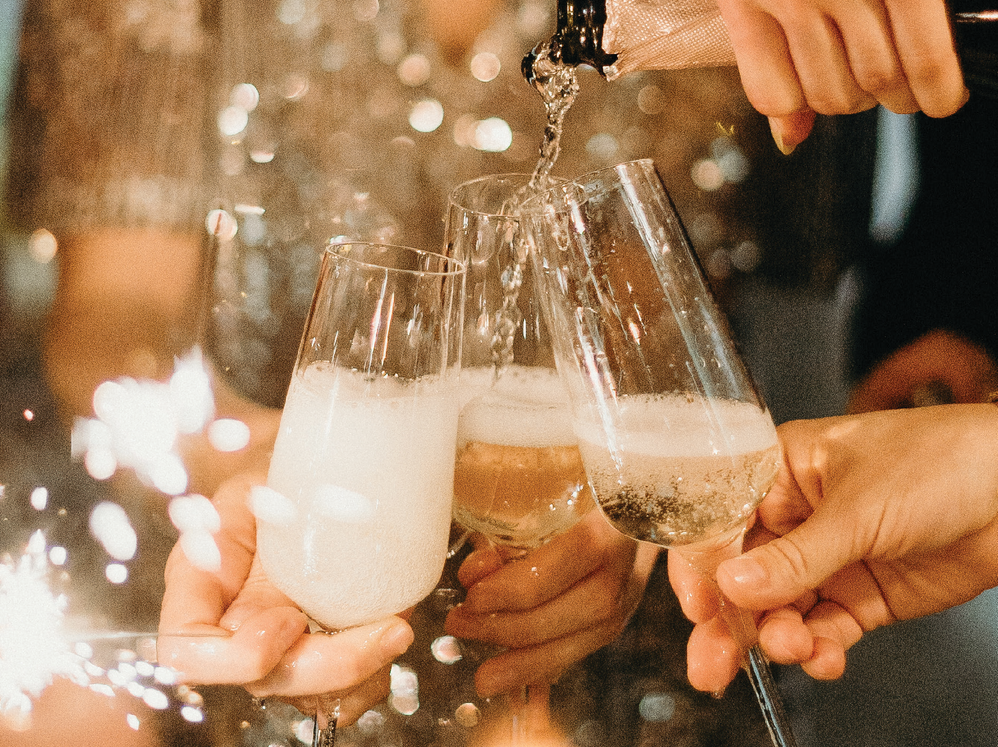EXPLORING NAPA VALLEY’S EXCITING EFFERVESCENT WINES
With tiny streams of bubbles and bright effervescence that dances across the tongue, a glass of sparkling wine seems alive. And while champagne, prosecco, and California bubbly all sparkle, each one has a unique personality. Champagne is toast and minerality, and Prosecco is soft and floral. And just like California is about sunshine, so is Napa Valley sparkling wine.
In the early days, California winemakers were inspired by the best French wines. After all, the 1976 Judgment of Paris tasting made connoisseurs take Napa wines seriously. In the early days, California sparkling winemakers used the same grapes and the same méthode champenoise, with a secondary fermentation in the bottle, to try to create an American version of champagne.
But those days are over. “We’re able to make sparkling wines that rival the best in cham- pagne,” said Hugh Davies, owner, and CEO of Schramsberg, the winery his parents founded in 1965. From prestigious houses like Schramsberg and Domaine Carneros to nontraditional bubbly made by Tank Garage Winery and CARBONISTE, California sparkling wine houses are doing their own thing. “There are truly some fantastic Napa Valley sparkling wines,” said Winemaker Dawnine Dyer. “They’re some of the most complex and enjoyable wines around.” Now she makes Bordeaux blends on Diamond Mountain with her husband, Bill. But Dyer made history, and lots of fine California sparkling wine, as Domaine Chandon’s first American winemaker from 1978 to 1999.
Living the Dream
The best bubbly begins with grapes that are picked early, when they’re just ripe and bursting with acidity. With cool, foggy mornings and sunny days, the Carneros region offers ideal conditions for sparkling wine. That’s why all the major Napa Valley sparkling wine houses–Mumm, Chandon, Schramsberg–source fruit from the appellation.
Domaine Carneros’ estate vineyards are all in the Carneros region, where San Pablo Bay breezes and gentle fog create wines that are crisp and refined. “We’re a cooler region, so the fruit matures more slowly,” said Eileen Crane, head winemaker and CEO for 34 years. “You get more flavor evolution over the growing cycle.” Crane said the wines make a statement that’s fun, but substantive. “I think of our style as Audrey Hepburn in a little black dress,” Crane said. “Everything is in its place, very elegant but not overdone.” Domaine Carneros’ Le Rêve, their signature wine made from 100% Chardonnay that’s aged on proprietary yeast for six years, is a dreamy example.
As Crane prepares to retire and turn over winemaking to Zak Miller, she’s looking forward to having time to relax in their newest tasting salon, Jardin d’Hiver. The glass-walled room with 180-degree views, is decorated with skylights, chandeliers, and Chinoiserie-inspired hand-painted panels. Its lines match the Louis IV-style winery, which is a larger version of the Taittinger family’s home Château de la Marquetterie.
At Schramsberg in Calistoga, Davies is ensuring that his parents’ dream lives on. Looking back, Davies is amazed that two LA kids with backgrounds in aerospace marketing and art launched their own winery.
“They really had no business doing a winery,” Davies said. “Their parents didn’t drink wine, and they didn’t have a farming background either.” Jack and Jamie Davis were investors in the original Martin Ray Winery near Saratoga. In 1965, those connections helped them start Schramsberg. Their goal was to make America’s first méthode champenoise wine with Chardonnay and Pinot Noir. But first, they had to track down the Chardonnay. “They found some Chardonnay they could work with from Spring Mountain,” Davies said. “At that moment, there were only 200 acres of Chardonnay in the whole state.”
That’s not a problem today, and he’s about to release the 2016 vintage of Querencia Rosé, a “snappy and crisp” blend of Carneros Chardonnay and a Pinot Noir to add red berry notes. It helps fund his father’s trust devoted to preserving agricul- tural lands in the Napa Valley.
Davies carries on his parents’ legacy while maintaining the historic winery with 35,000 square feet of caves dug into the side of Diamond Mountain. “This was their dream. You feel that history here,” he said. “The wine folks in the Napa Valley have con- tributed something to American culture.”

Mumm Napa Valley Winemaker Tami Lotz is a Napa native who learned to love bubbly young. “Sparkling was the first wine I ever tasted,” she said during a phone interview. “I love the acidity of sparkling wine. It has such a bright personality.” Mumm Napa’s house style is all about freshness and fruit. Carneros Chardonnay gives her wines a green apple note, while Oak Knoll fruit tends to yellow apples and stone fruit. “Each of the houses has a unique personality. For us, it’s finding a balance with fruit and yeast, but we want to have a lot of fresh fruit in our core wines, and the yeast should be the accent,” said Lotz.
For an unrivaled experience, Lotz recommends sipping the DVX, their prestige wine or tête de cuvée, while sitting overlooking their garden. It’s named after Guy Devaux, who was assigned to find the best place in the U.S. for G.H. Mumm to start a sparkling wine house. She makes that blend from the best fruit each vintage, and then it’s aged for five years on yeast. The final wine has toasty elements, but the distinct flavors of Chardonnay and Pinot Noir come through.

Something Old, Something New
You never know what those guys at Tank Garage Winery in Calistoga will come up with next. All of Tank’s wines are limited editions; they make a small amount, and when it’s gone, that’s it. They have been playing around with pét nat (short for pétillant naturel), an ancient style of wine- making where winemakers create wild wines that are fermented in one bottle.
As grape juice starts fermenting, it’s bottled and capped. The CO2 gas gets trapped in the bottle, creating a sparkling wine. Sometimes the fermentation stops, so the wine isn’t bubbly. Other times, it’s too vigorous, so the wine explodes out of the bottle. Getting it right is challenging. “It’s a delicate balance,” Bertus Van Zyl, consulting winemaker at Tank, said.
Luckily, their experiments have been happy ones: the Pop-Nat sparkling Barbera and a carbonic macerated Petite Sirah that tasted like a “cherry Otter Pop” both sold out within weeks. Their late spring sparkler was Super Geisha, a blend of Picpoul de Pinet and Tocai Friulano from a vineyard in El Dorado County. “I think the thing about pét nat I enjoy the most is you’re not so held by tradition,” Van Zyl said. “We find these things that scratch an itch or answer a question: what would happen if you try this as a sparkling wine?”
CARBONISTE’s Dan Person earned his sparkling wine chops at Schramsberg, and now he and his wife Jacqueline are making pét nat wines. Their range, which is made from Pinot Noir, as well as Albariño and Pinot Grigio, is designed to be fresh and easy drinking. “We like to say Champagne is from France, and CARBONISTE is from California,” Person said. “In California, we have abundant sunshine and that flavors the fruit differently. You can always taste that, and it creates a natural sweetness, brightness, and fruitiness that champagne doesn’t have.”
Their flagship is the Octopus, made from Albariño grapes grown in the Sacramento Delta. Another favorite is the Sea Urchin, a Pinot Noir brut that is bursting with dry red fruit. Drinking his wines, Person wants people to feel like they just picked a grape and then ate it. “The wine you taste in the glass tastes like the juice that was in the tank,” he said. Their newest offering is the Rouge Brut, a fanciful red blend of Merlot and Albariño that’s a perfect partner for barbecue or the Thanksgiving table. They also make a higher- end appellation series that show- cases fruit from Marin and Santa Cruz Mountains.
Innovative sparkling wine is current, but it is also part of California’s history. The Korbel Brothers started making cham- pagne method wines with Pinot Noir back in 1882. In the modern era, Hanns Kornell launched his pioneering brand of make méthode champenoise sparkling wine in 1955. His father and grandfather made aromatic and mineral-driven Riesling Sekt in Germany, so he used that grape too. His daughter Paula said every day was a celebration in their house. “It was wonderful to grow up with him. He always found beauty in nature and animals,” Kornell said. “There’s not a day that goes by without saying, God, we’re so lucky to be where we are.” The Hanns Kornell brand folded in 1992.

When Pat Roney of Vintage Wine Estates gave her the chance to pick up where her father left off, Kornell jumped at the chance. The first vintage of Paula Kornell Sparkling Wine debuted in fall 2019. “I love acidity and yeastiness, and I really like acidity and dryness,” she said. The Blanc de Noirs is lean and focused, while the Brut is generous with crisp fruit. She feels lucky to be working with winemaker Robin Akhurst, and sourcing top quality Chardonnay and Pinot Noir from sites including Mitsuko’s Vineyard in the Carneros. Her distinctive logo of workers carrying grapes out of Canaan is a tribute to her father. Kornell loves pairing bubbly with food, so her tastings feature cheeses and truffle salt. At a recent lunch, she matched the
Blanc de Noirs with green tomato soup, while the non-vintage brut sang with herb-crusted salmon and gnocchi. “Back then, we were trying to teach people to drink bubbles on a regular basis,” Kornell said.” Now it’s in people’s brains they can drink it any old time.”.
For more information:
Domaine Chandon
1 California Drive, Yountville
Domaine Carneros
1240 Duhig Road, Napa
Schramsberg
1400 Schramsberg Road Calistoga
Mumm Napa
8445 Silverado Trail Rutherford
Paula Kornell
Tank Garage Wine
1020 Foothill Blvd, Calistoga
CARBONISTE
Article By: Marcia Hunt

